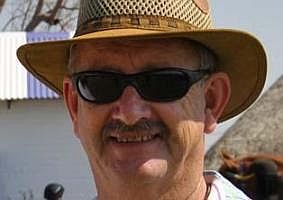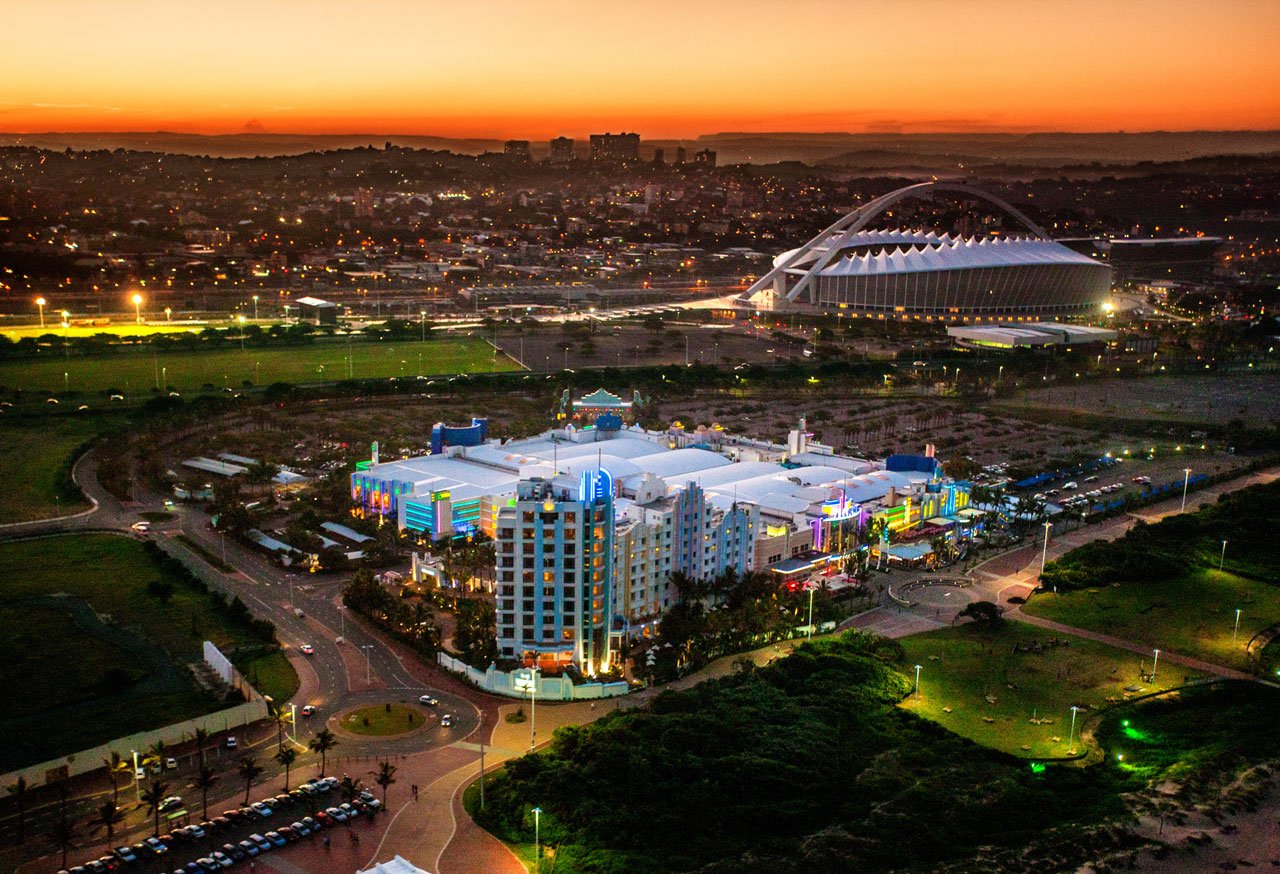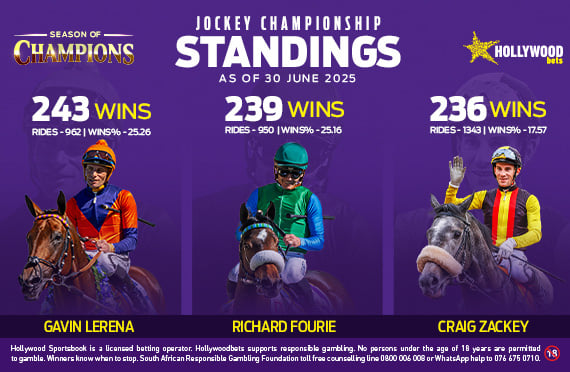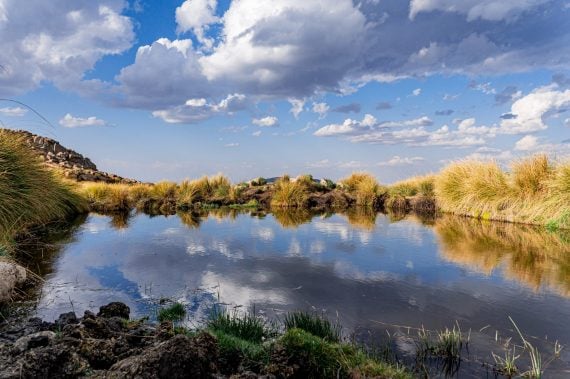Trainer Sean Miller’s remarkable training feat of six winners at Flamingo Park on Monday was a fitting tribute to his late father and mentor, Peter, who passed away a year ago this coming Monday.
There are those that will argue that the young Sean, only 21 years old when his father died, landed with his proverbial in the butter. He was handed a thriving and successful business on a platter. A business that had been Kimberley champions for nine seasons on the trot and had even achieved a best performance of a third position on the national log in 2006/2007, with 127 winners.
The rugged icon of Northern Cape racing was only sixty when he died of a heart attack on 23 April 2011, three months after being diagnosed with leukemia. He was the face and the outspoken voice of Kimberley racing for many of us and legend has it that he drove the tractor that rolled the track, grilled the steaks, poured the beers and even painted the rails, in between chairing Stipe’s boardroom objections. He was also a Tellytrack presenter, although it became a bit silly in the end as he landed up talking to himself as the winning trainer in most of the post-race interviews. I could find no record of him ever having called a race.
A leader is what Phumelela needed in Kimberley and Miller stepped into the role with enthusiasm and aplomb. He rolled up his sleeves, initiated an upgrade to the racecourse, got involved in the Racing Association and gave the place some ‘rigting’, as the locals would put it.
At the time, with all of his three years stable experience when taking over the 85 strong string, Sean went on record as saying that his father had played a big role in all their lives and that they would honour his memory. “This is the way he would’ve wanted things to continue. He wouldn’t want us to cry too much, he’d want us to carry on with the job!”
And carry on with the job, he certainly has. Peter’s Port Elizabeth satellite yard dream has become a reality and things are running very smoothly. On Monday Sean also mentioned the important role played by his Mom Stephanie, who he said had become involved in the running of the yard and also his girlfriend Cornel.
The biggest single Miller patron is the Ingrid and Markus Jooste partnership. And Sean looks almost sheepish when his own silks are in the winner’s enclosure. Thankfully the spoils were shared evenly on Monday with the Joostes taking three and the Millers three.
The talking horse of the day was the Albert Hall gelding Kensington Gore, who has proven a revelation since putting a hoof on sand. A horse who had finished an accumulated total of 115 lengths back on his three previous turf runs in PE, he has now won his only two starts on sand by close to double figure margins in total. He streaked clear under replacement rider Hennie Greyling to win the non-black type Northern Cape Stayers Handicap over 2200m easing up.
Miller called him the ‘next Lawful Leader’ in a reference to the now retired Wilgerbosdrift owned grey Roi Normand gelding, who left Dean Kannemeyer’s yard a maiden in March 2007 and who went on to win seventeen races over the next four seasons with Peter Miller in Kimberley.
For those who are unclear as to the origins of the gelding’s name, Kensington Gore is a street in central London. It runs along the south side of Hyde Park. A gore is actually a narrow, triangular piece of land. Kensington Gore is also the generic name for movie and theatre blood and several thousand litres of it was used in the Stanley Kubrick film , The Shining.
But I digress. Another interesting Miller winner on the day was the Lundy’s Liability filly Sound Track, who was claimed twice from 20-1 to 6-1 and won the jackpot opening leg easing up from stablemate Shopping Paradise, to land a betting coup. S’Mango Khumalo only had two Miller rides on the afternoon and he won on both of them. Us punters watch the jockey choices and we wouldn’t have seen this one coming, although Miller was quite transparent earlier. His quip that ‘I’m seldom wrong’ is a sure sign of youthful naivete and may return to bite him!
Hollywood sponsored trainer Cliffie Miller, who has 25 open boxes, trained a rather humble looking double on the afternoon in comparison. His post-race quip after his final race winner on the lines of ‘we need competition in Kimberley’ is a sentiment undoubtedly echoed by many of the locals. Ten of the nineteen Sean Miller runners on Monday are owned by the Joostes and their support has created a huge imbalance of power. Unlike in the other centres, where the Joostes support a cross-section of yards, their Kimberley horses are only stabled in one yard.
Competition is not a positive word in racing right now. But the big man pays the bills, and who he decides to get to train his horses is his prerogative.
Not So Grand
The 2012 John Smith’s Grand National was once again a poor advertisement for the sport of kings. After watching the 7200m race, I am amazed that only two horses died.
I suppose they will argue that only 5% of the field died. The original favourite Cheltenham Gold Cup hero Synchronised, who attracted three times as many bets as any other horse in the forty strong field, and a fellow called According To Pete were both victims of the notorious Becher’s Brook. A Bookmaker was quoted as saying that if Synchronised were to win, ‘the colour would drain from every bookmaker’s face followed by all the money in their satchels.’ Well they needn’t have stressed. The favourite is dead.
The race was won by the eleven year old Neptune Collonges, who became the first grey winner of the race for 62 years when he beat Sunnyhillboy by a nose, in the closest ever finish in the 173 year history of the National. He was trained by Paul Nicholls and ridden by jockey Daryl Jacob. The grey was retired immediately after the race by owner John Hales.
Neptunes Collonges is one of the lucky ones. His owner has banked the cheque and he now looks forward to a wonderful retirement. The owners of Synchronised and According To Pete are probably looking at life slightly differently. The British Horseracing Authority issued a statement on Monday.
“We will be collating all the relevant information and data from this year’s Grand National meeting so that it can be reviewed in conjunction with the statistics and findings of the Review.
“Initiatives such as speed sensing on the runners in races over the Grand National course will enable BHA and Aintree to make informed decisions based on factual evidence in our efforts to minimise risk where possible.
“The evidence indicates that the changes and improvements in safety made over the years have led to an overall decrease in injury and fatalities, both on the Grand National course and racing in general.
“It is important these matters be judged over a period of time. The decade since 2000 was the safest on record for the Grand National with a fatality rate of 1.5% compared to 3.3% at the start of the 1990s.
“Sadly, there have been two fatalities in each of the last two runnings of the race. Naturally our objective is for there to be no fatalities, but we also recognise that we cannot remove risk altogether from such a competitive activity.
“The Grand National is a unique race and it represents a unique challenge for the sport and for its regulation.
“It is a thrilling spectacle, but there is a higher degree of risk involved in the Grand National than other races and for this reason everyone in the sport needs to be conscious of how the race is presented to the public, the general consumer perception and their views of how the race is run.
“This is an event that generates huge public interest and has a global audience of more than half a billion people. We’ve seen record crowds of over 150,000 in attendance at Aintree this week, following on from record numbers through the gates to British Racecourses in 2011. All of this suggests that British racing is doing many things right in the eyes of the consumer.
“It is critically important to us that the good work being done in racing is not overshadowed by yesterday’s events, and that racing continues to work collectively to develop and maintain this progress.
“In this context, we will be working with Aintree and its owners The Jockey Club, along with other groups in the sport to find the right balance which enables us to maintain the highest standards of safety for our horses and participants and to promote the sport to the widest possible audience.”
Teenage Sensation
New Kimberley trainer Tienie Prinsloo provided 19 year old Apprentice Jayson ‘Teenage’ Dladla with his first career winner at Flamingo Park on Monday. Dladla rode a cracker on the 33-1 shot Cannonball who paid R47-40 for a tote win and got the better of the powerful Sherman Brown in a driving finish to the sixth race. In a bizarre moment, Dladla did his own version of the ‘Brown Bounce’ as he passed the talented senior jockey with the inimitable style.
The former Jaap Visser-trained Lavery gelding appeared to relish the increase in distance and stayed on well to win. Dladla, who hails from KZN, will be riding in Gauteng and Kimberley, and his claim 4kg services should be snapped up by the local trainers.
Dladla,w ho lists ‘soccer and girls’ as his non-racing interests, says the best thing about being a jockey is that ‘you earn big bucks.’ We wish him well.









